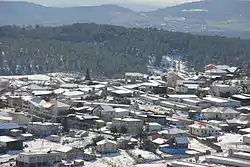Dalton, Israel
Dalton (Hebrew: דַּלְתּוֹן) is a moshav near Safed in northern Israel under the jurisdiction of Merom HaGalil Regional Council. It was founded by immigrants from Tripoli in Libya in 1950 under the leadership of Hapoel HaMizrachi. On the grounds of the moshav is a tomb ascribed to Rabbi Yosi Haglili and his son Yishmael. The economy is based on agriculture, the Dalton Winery and a guesthouse. As of 2019 it had a population of 862.[1]
Dalton
דַּלְתּוֹן | |
|---|---|
 | |
 Dalton  Dalton | |
| Coordinates: 33°0′58″N 35°29′15″E | |
| Country | |
| District | Northern |
| Council | Merom HaGalil |
| Affiliation | Hapoel HaMizrachi |
| Founded | 1950 |
| Founded by | Hapoel HaMizrachi |
| Population (2019)[1] | 862 |
| Name meaning | Kite (geometry) |
History
Dalton is mentioned in medieval literature and documents discovered in the Cairo Geniza. In the Geniza there is a portion of a letter sent from Dalton to Egypt which is signed by "Shlomo HaKohen from the city of Dalton, son of Yosef." Also, regarding the wise man Eliyahu HaKohen who died in Tyre in 1063, it is written that all of Israel carried his body on their shoulders to a mountain in the Galilee, to Dalton atop the mountain.[2] According to local tradition, Rabbi Yosi HaGlili and his son Yishmael are buried in Dalton. The former's ohel is located here. The editors of a Hebrew book "Holy Places and Graves of Righteous Men in the Land of Israel" believe that Yosi Haglili's son is really Rabbie El'azar, a fourth-generation Tanna, and not Rabbi Yishma'el. The mistake apparently derives from the fact that there was also a Tanna named Rabbi Yishmael ben Rabbi Yose, but he was a fifth-generation Tanna. Rabbi Yosi Haglili was a third-generation Tanna at the beginning of the 2nd century CE and was one of the scholars of Yavne.[3]
Dalton was established on the land of the Palestinian village of Dallata, which was depopulated in the 1948 Palestine war.[4]
Archaeology
.jpg.webp)
In a ruin outside the moshav are remnants of an old synagogue. Later a marble pillar was found in the synagogue with an Aramaic inscription which includes text found in other contemporary synagogues. It roughly translates as "The ruler of the world is remembered for good."[5][6][7]
In May–June 2006, a salvage excavation was conducted near Moshav Dalton prior to the construction of a communications antenna. The excavation was carried out on behalf of the Israel Antiquities Authority. The site, about 500 m northeast of the moshav 50 m west of the local cemetery, is situated on a rise at the foot of Mt. Dalton, which overlooks the moshav. The excavation area is on the edge of the abandoned Arab village of Dalata. Earlier explorations turned up remnants of a late Roman–Early Byzantine period synagogue. During the Middle Ages, Dalata, as well as the nearby villages of Alma and Baram, were a destination for Jewish pilgrims and was populated with Jews. Dalata was mentioned in pilgrimage literature and a letter discovered in the Cairo Geniza.[8]
Geology
Near the pond in Dalton is a long depression surrounded by hard basalt rocks which appears to be from a secondary explosion of the type found on the slopes of a volcanic mountain. Sometimes volcanic ash expelled in eruptions covers an area with standing water, creating secondary explosions and flows.
Dalton winery
The Dalton winery, which released its first 50,000 bottles in 1993, is now producing 880,000 bottles annually, including Cabernet Sauvignon, Merlot, Sauvignon blanc and Chardonnay. Its vineyards are near the border with Lebanon.[9]
References
- "Population in the Localities 2019" (XLS). Israel Central Bureau of Statistics. Retrieved 16 August 2020.
- Vilnay, Zev (1980). Guide to the Galilee (in Hebrew). Jerusalem: Ahiavar. p. 323.
- Menachem Michalson, Yehuda Solomon, Moshe Milner (1996) Holy Places and Graves of Righteous Men in the Land of Israel ("מקומות קדושים וקברי צדיקים בארץ ישראל"), Ministry of Defense Publishing, pp170–178
- Khalidi, Walid (1992). All That Remains: The Palestinian Villages Occupied and Depopulated by Israel in 1948. Washington D.C.: Institute for Palestine Studies. p. 443. ISBN 0-88728-224-5.
- Zvi Ilan (1991) Ancient Synagogues in the Land of Israel (בתי כנסת קדומים בארץ ישראל), Ministry of Defense Publishing
- Yosef Barzilai (1954) Survey of our Country, Past and Remains (לחקר ארצנו, עבר ושרידים), pp274–275
- Yosef Noah (1978) Mosaic and Stone (פסיפס ואבן), pp144–146
- Har Dalton Archived 2011-09-28 at the Wayback Machine Archaeology News, 4 September 2008
- A small winery with a big reputation Haaretz, 27 May 2009
